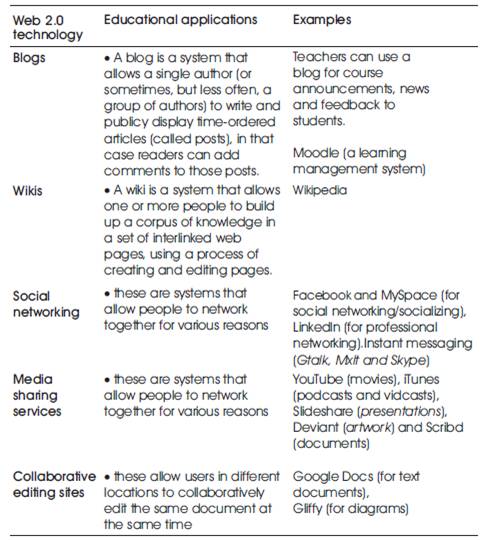
Table 1.Web 2.0 technologies in Higher education (Franklin & van Harmelen, 2007)
In a typical South African contact university, where learning and instruction is done following a strict class schedule, the challenge of providing personalized learning support is still prevalent. This paper argues that the advent of Web 2.0 affords varied opportunities to cushion this challenge, faced by learners. In this paper, social presence theory acts as a lens to provide an informed understanding of the interactions provided by the varied Web 2.0 applications. Empirical evidence was gathered at Tshwane University of Technology through contextual inquiry research methodology. The evidence suggests that the varied Web 2.0 applications have the potential to alleviate the preceding challenge by creating a personalized learning environment where learners may interact, share knowledge and collaborate with those who are not in the same location. This, in turn, strengthens the learners' skills as they interact with knowledgeable peers and instructors. The paper concludes that utilizing Web 2.0 appropriately may alleviate the challenge of providing personalized learning support, faced by South African higher education.
This paper discusses how Web 2.0 can be utilized to provide personalized learning support in a higher educational environment. Web 2.0 is a term that is now commonly used to describe a range of what is described as 'social' technologies that allow users to interact with each other in a range of environments (Boyle & Jackson, 2009). This interaction allows users to share, interact and collaborate amongst each other. This rise of Web 2.0 has led to an explosion of new tools and technologies that foster online collaboration and communication (Shepherd & Vogel, 2009).
Although many learners in South Africa come from diverse social and educational backgrounds, almost all of the institutions of higher learning adhere to the traditional way of teaching and learning. That is, there are contact universities where teaching takes place in formal settings - the instructor delivers a lecture and the learners are passively participating.
The effectiveness of learning is affected by the social interaction and the context in which it takes place (Kekwaletswe & Ng'ambi, 2006). To this point, there are three types of contexts where learning happens and subsequently where a learner needs personalised support. These are formal learning contexts - these contexts represent formal structures such as scheduled lecture sessions); Semi-formal learning contexts - this signifies informal spaces on campus used by learners, usually while waiting for the next lecture to start or after it finishes; and lastly, the informal learning contexts - includes working during after hours or weekends at university residences or private homes (Kekwaletswe, 2007).
While a contact university schedule may be an effective method of delivering a learning content, it does have its challenges. For example, learners are restricted to a specific time and place to learn. This suggests that information may only be acquired at a stipulated venue and time according to a set schedule - the setting is seldom conducive for interaction as information communication is predominately one way, from the educator to the learner. That is, knowledge is not shared but rather imposed onto the learner; Medium of instruction, English Language, may also pose a problem. While learners informally interact in their individual mother tongues, they are required to interact in English while in the formal setting – which is not necessarily a medium they may be able to use to fully express themselves; Consultation with instructors is also limited - learners may only get access during formal consultation hours; Diverse social backgrounds, between instructors and learners, may have an adverse influence on the social presence required, where learners may lack the ability to project their social characteristics during class (Tsela & Kekwaletswe, 2009).
To the preceding challenges, this paper argues that South African universities should fully utilize Web 2.0 in order to provide the much needed personalized learning support. In this paper, personalized support means help or learning support that is sensitive to the learner's background and context. The focus of this paper is on how Web 2.0 tools could enhance learning support, by identifying means that enable learners to interact with peers, who often share a background, while in varied learning contexts. Thus, particularly addressing the challenges experienced by learners in the South African higher education environment.
On a daily basis, learners use Web 2.0 applications to socially exchange information and share experiences. This in turn results in learners becoming dependent on these Web 2.0 applications as they carry out their normal activities. Therefore, Ajjan and Hartshorne (2008), emphasize that with the emergence of Web 2.0 technologies into everyday life of students, it is important to explore faculty use of Web 2.0 technologies to support teaching and learning in higher education. While many people are beginning to make use of Web 2.0 technologies in learning and teaching, much of this is still experimental work carried out by enthusiastic lecturers who are willing to devote the time to make the technologies work for their teaching (Franklin & van Harmelen 2007) (Table 1). In light of helping learners with modern technologies, Web 2.0 tools have been applied in education environments (Chin, Wen & Sheng, 2009)

Table 1.Web 2.0 technologies in Higher education (Franklin & van Harmelen, 2007)
The high utilization of Web 2.0 applications is made possible by the advantages that are associated with them. Reduction of costs; Flexibility, as far as the possibility of choosing technologies is concerned; Easier and faster access to information, when and where it is needed; The integration of a variety of Web 2.0 technologies in the teaching-learning activities; Sharing accumulated experiences (blogs, microblogs, wikis, flickr, YouTube) and resources; The low level of complexity needed for use (minimum skills in using the Internet). The growing use of mobile devices and wireless communication technologies enables access to contents at any place at any time, thus providing a new, more flexible educational method – mobile learning (Georgiev, Georgieva & Trajkovski, 2006).
South African universities that have begun to take the opportunity to use Web 2.0 to encourage learner interaction are i) University of Cape Town - Lectures are using Wikis and blogs to facilitate supervision of postgraduate students. Students are asked to use a blog for note taking and tracking their activities, and store their notes from meetings with supervisors on a Wiki. The advantages of using these Web 2.0 applications were noted as including the timeliness of information on the blog, and the ease of collaboration through the joint editing functionality provided by the wiki (Franklin & Armstrong, 2008). ; ii) Rhodes University: At Rhodes University, computer science students have been involved in experiments around developing course content in a variety of languages for bringing course for students whose first language is not English. A Web interface allows students to access materials developed by volunteer students and to participate in online chat sessions in a variety of languages. The system comprises a chat room, an online glossary and a knowledge base or newsgroup (PHEA, 2008).
Tsela and Kekwaletswe (2009) posit that for learning interaction to happen, there must be social presence - however, this is not always the case in a contact university. Social presence gives a sense of the extent to which a communication medium facilitates awareness of the other. It is a measure of the feeling of community the learner experiences (McIsaac & Gunawardena (1996), Stein and Wanstreet (2003) conclude that the greater the perception that social presence exists, the better the ability to substitute telecommunications media for face-to-face encounters and still achieve the desired collaborative outcome. Wheeler (2005) states that social presence is an important component of any learning situation and doubly important in electronically mediated contexts.
The point to note is that social presence enables learners to engage in a learning interaction, with the intention of achieving a personalised learning. In this paper, awareness of social presence means that a learner is able to identify an appropriate and knowledgeable peer who is availalbe for learning interaction. The knowledgeable peer often shares a social background. (Sallnas et al., 2000) states that mediated social presence involves social interaction using a communication medium, such as instant messaging, to come to know the meanings, cognitions, emotions and behaviours of another mind.
The awareness of a social presence is achieved through Web 2.0 applications or tools with varied social presence indicators. Communication media with good presence indicators include Instant Messaging (IM) and Facebook, among others. In South Africa universities, learners access these tools mostly with their mobile phones than with the wired computer desktops. This is because almost all learners have access to or own mobile phones as opposed to owning a desktop or laptop computer. Having constant access to a mobile phone means that social presence is likely to be maintained regardless of one's location (Howe & Kekwaletswe, 2010).
The Personal Learning Environment has been an emerging theme of discourse in the e-learning community for some time. It has emerged from a variety of different sources, including the body of opinion which has grown in the light of experience of e-learning developments to date (VLE, ePortfolio, etc) and acknowledges some of the weaknesses of existing e-learning provision (Johnson & Liber, 2006). PLE are Web sites or services where learners are able to produce learning content or reflections and sore documentations about their learning processes (e.g. Weblog postings). Furthermore, users should be able to aggregate data from their learning communities, e.g. through RSS feeds of interesting Weblogs (Hilzensauer & Schaffert, 2008). In a personal learning environment, the learner has the available Web 2.0 tools (Facebook, Instant messaging etc) to engage in interaction and collaborating activities. Some of these activities can easily be transferred to learning activities, given that the learning platform already exists.
Milligan, Beauvoir, Johnson, Sharples, Wilson & Liber (2006) suggested that, in a Personal Learning Environment (PLE), the learner would utilise a single set of tools, customised to their needs and preferences inside a single learning environment. The tools would allow the learner to: Learn with other people: managing their relationships with tutors, and peers, as well as form links between contacts who are not part of their formal learning network; Control their learning resources: enabling them to structure, share and annotate the resources they have been given along with those they have found or created themselves, or been given by their peers; Manage the activities they participate in: providing them with the opportunity to set up and join activities such as study groups, bringing together a specific group of people, together with the appropriate resources; Integrate their learning: allowing them the opportunity to combine learning from different institutions, re-using previously generate evidence of competency or making links between formal and informal learning.
A scenario where a PLE can be formed is when a group of learners, who often share a background, interact and collaborate using one common language, since South Africa has 11 official languages. This usually occurs when learners have difficulty writing and expressing themselves in the language of instruction. In the South African Higher education environment, English is the medium of instruction (Howe & Kekwaletswe, 2009). In this situation, learners utilize any Web 2.0 application to share and put across information to their fellow learners.
As the concept of personalized learning becomes increasingly popular, it advocates that instruction should not be restricted by time, place or any other barrier and should be tailored to the continuously modified individual learner's requirements, abilities, preferences, background knowledge, interests, skills, etc (Sampson, Karagiannidis & Kinshuk, 2002) .The promise of Personal Learning Environments could be to extend access to educational technology to everyone who wishes to organize their own learning. Furthermore the idea of the PLE purports to include and bring together all learning, including informal learning, workplace learning, learning from the home, learning driven by problem solving and learning motivated by personal interest as well as learning through engagement in formal educational programmes (Attwell, 2006) .
In terms of taking control of their individual learning argue that learners based this decision on their personal goals and that better outcomes are achieved when the learner maintains control throughout the four phases of the learning planning process; Phase 1: Learners determine their own learning needs so as to achieve their personal goal; Phase 2: Learners create their own learning strategy and the resources to achieve the learning goals; Phase 3: Learners implement their own learning strategy and use the learning resources; Phase 4: Learners evaluate the attainment of the learning goal and the process of reaching it (Knowles, Holton & Swanson 2005).
Empirical evidence was gathered using contextual inquiry methodology. Holtzblatt and Jones (1994) define contextual inquiry as a field research framework that depends on conversations with users in the context of their work. It is based on ethnography, where the researcher goes into the research participant's own environment. It was crucial to obtain the evidence in its most natural state, so that closely accurate representative evidence is presented. For this study, Tshwane University of Technology was used as a case study.
The collection of empirical data was through an openended questionnaire, contextual interviews and blog messaging (textual interactions). The questionnaire was to gather as many responses as possible, covering a wide number of learners that reside at university residences and off-campus. The questionnaire was handed out to participants in the university student centre, cafeteria, libraries, shuttle and bus stops, and classes. That is, participants were in different learning contexts or locations. The whole idea was to cover the diverse areas with learners having different backgrounds (including gender, class levels and faculty), which would represent the population of the learners in a typical South African university setting.
Subsequent to filling in the questionnaire, learners who showed interest in participating further in the study were contacted to partake further in the last phase of the study – which was the mediated textual interaction via mobile instant messaging and the contextual interviews conducted as they were engaged with authentic learning tasks.
The different responses and comments gathered from learners who filled in the questionnaire on why they use Web 2.0 applications are listed below: This collection of different responses also highlighted various comments from learners from different backgrounds (Table 2).
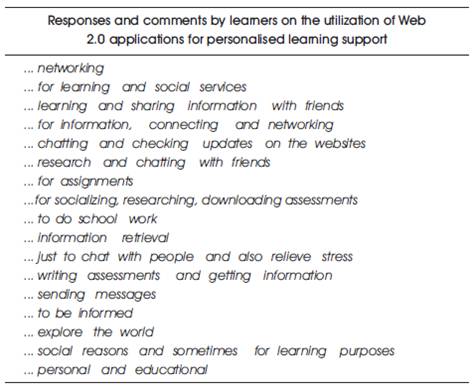
Table 2. Learners' comments on how they use Web 2.0
The responses show the different ways learners use Web 2.0 applications. Since personalized support comes in varied forms, it could be seen that indeed Web 2.0 applications may be appropriate for providing personalized learning support. A personalized environment is formed by the learner's intention to learn. The above responses also show that learners are already interacting socially using Web 2.0 applications, hence easier for them to incorporate the tools for learning actions. Thus, instructors could easily take advantage and use the same applications to interact with learners, exchanging learning resources.
With the contextual interviews, the idea was to get a better understanding of how and why learners utilize Web 2.0 technologies in a given situation. The following activity occurred during the university test week. This is a period where learners are writing and preparing for their semester tests and examinations. Appointments with participants, were made to meet with them at various university formal and informal locations, such as the library and cafeteria.
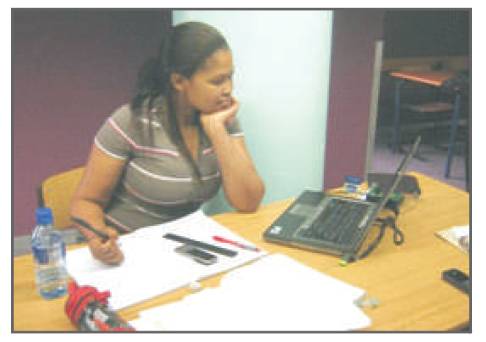
Figure 1. Participant in the library studying using her laptop and mobile phone
Contextual question: Hi, it seems you serious with your studies, do you mind if I join you and ask you a few questions while you study? I promise it won't take more than 5 minutes.
Response: Oh. Ok I guess it would not be a problem.
Contextual question: So, are you preparing for a test or what?
Response: Yeah, im writing on Monday
Contextual question: Are you ready for it?
Response: At the moment I think I do
Contextual question: What course are you doing?
Response: Electrical engineering
Contextual question: Sounds like a tough course, then what if you come across a problem that needs further explanation?
Response: I usually get in touch with my classmates
Contextual question: How?
Response: If I do not see them in class I send them a message using Facebook
Participant seemed confident because she is aware of her situation, that she needs assistance with her studies. Since her friend is in a different location, social presence plays a very important role in this situation because she can interact with the friend, allowing her to share her learning problem to her friend. The location of her friend did not stop her from taking control of the learning activity, as she could send in questions, receive textual responses through her mobile phone. Figure 2 shows the participant using her mobile phone to interest with another learner.
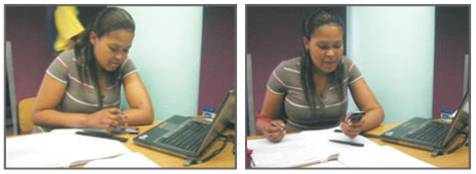
Figure 2.Participant using her mobile phone to interact with another learner
Contextual question: So you do not use Facebook for chatting purposes only?
Response: Not always. Actually right now, im chatting to my classmate. She is also preparing for the same test. We are discussing some of the possible questions for the test. It just that she is at her flat....a couple of minutes before you came, I asked her to explain to me some definition....and look she has just responded.
Contextual question: Ok, so how do you feel that she has now responded?
Response: Happy, especially when she was online, coz a while go I did not understand some section in chapter 4, so she was able to briefly explain it and text it back to me.
Participant is consciously at ease now that she knows her friend is available to help her with her learning challenge. She took advantage of the social presence of her peers to personalize her learning
Contextual question: Interesting, so what about the laptop?
Response: It contains some of my notes that I typed out during class, so I am just reading through them
Contextual question: Thank you for your time, my 5 minutes is almost over. Good luck with the
Response: Thanks.
The Web 2.0 application that was used (Facebook) allowed the learners (Participant and her friend) to socially interact with one another, since they were located in different learning environments. The learners used their original Facebook accounts for conversation. In this scenario, social presence plays a crucial role because at that moment Participant realised that her friend was online, which enabled her to interact and exchange information about the test, enabling her to continue with the learning activity.
This section looks at how learners interact, using a learning site called BICOP. This application (BICOP) enabled learners to interact socially, while in different learning contexts, but experiencing the same learning goal (to finish the
assignment). This particular site is a learning site (BICOP) belongs to one of the departments (Informatics) in the Faculty of ICT. Basically this site allows students to post questions (as in Figure 4) to their fellow classmates, search for jobs, internships and communicate with lecturers, on issues like mark queries, assignments and subject content.
Conversation
Contextual question: Howzit
Response: Hey Mr Howe
Contextual question: What are you busy with?
Response: The usual…you know…checking my mail
Contextual question: All this websites are opened…which is which?
Response: Don't worry, will close them soon, but im focusing on this one (pointing on the screen to show me)
Contextual question: Oh I see you…BICOP
Response: Yah, this site is useful u know, coz I can communicate with my lecturers and my friends
Contextual question: Why do you use this site?
Response: Because it contains information that I can use, information that talks to me…
Contextual question: Information like what?
Response: like my subjects, job and internships, IT articles, a chat room and a forum where I can post questions if I need help…even here there is a section where it contains information to the subject im currently doing, DSO35bt.
Contextual question: what type of subject is it?
Response: It is a programming subject, Visual Basic…so at the moment im struggling with it, so I have just posted a message to anyone who can help me, coz we will be writing soon.
Mncedisi at this point decided to use BICOP for interaction with other learners on the basis of his need for personalized learning support. His awareness of other learners logged on the site would create an environment of personalized learning.
Contextual question: Oh I see, then why did you not consult with your lecturer
Response: Ahh, he is not around most of the time, because he spends of most of his time in Pretoria.
Contextual question: What about his consultation times?
Response: He does not have any here in Soshanguve
This learner is faced with a learning problem, so he decided to send a message to a friend.
Contextual question: Sounds serious neh?
Response: Yah, coz now I have to look for someone or for information to help me out
(While looking at his screen I could see that he had typed out something)
Contextual question: I see you typed something … what is it?
Response: That is the message I am posting on this forum about 2 weeks ago, stating my problem.
Figure 3 shows a screenshot of the message posted on the forum by the learner - Mncedisi: This shows that the learner is aware of the situation he is faced with, which in turn makes him feel not in control of his learning process. Below this message there were a couple of responses:
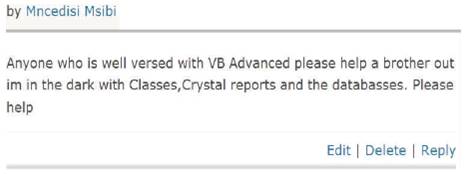
Figure 3. Message Posted by a Learner
Contextual question: So has anyone replied?
Response: Yes, only two people have responded
Figure 4 below is a screenshot conversation between learners, as one of the learners describes the problem that they have encountered.
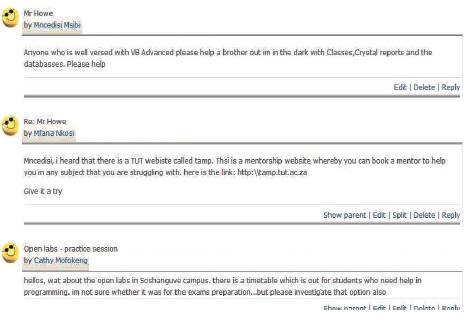
Figure 4. shows message interaction between learners helping one another to solve a problem
Excitement was noticed from his voice (Mncedisi) when he saw the two responses posted by other learners (Mfana and Cathy) not in the same location as him.
Contextual question: Good news?
Response: Yeah, now at least I know what steps to take
Contextual question: I can see you are relieved, smiling and snapping your fingers
Response: Of course I am.
Contextual question: That is good to hear. I have to go now. Thanks for your time
Response: No problem Mr Howe, see you around
The preceding scenario shows that learners in a difficult learning situation often need social presence of other learners in a social network. These learners used a learning site called BICOP to engage in textual message discussions. Through the utilization of this Web 2.0 application, personalized learning support was achieved since the learners were able to interact and share their learning concerns with each other. They were able to control their learning process by concentrating on what they needed to achieve.
The arrangement I had with Mirriam was that we meet outside her residence at about 6:15pm. This is the normal permitted time for visitors to visit. When I entered her room, I found her tidying up her study desk. She told me she was preparing for a test. I then proceeded to explain to her the whole process of this interview. I began the conversation with the first question I asked:
Contextual question: Since you are now preparing to study for a test tomorrow, how do you focus yourself to study?
Response: Since I am on a tight schedule I managed to make sure that I have the right information to study for.
Contextual question: Oh ok, how did you go about doing that?
Response: Before I came to my room, I meet my classmate who briefly gave me the scope of the test.
From this conversation, context awareness plays a very important role because the student is aware that she must continue learning and doing some work even after class. That is why this student made it a point to contact her fellow classmate to make sure she knows what to study.
Contextual question: It seems you enjoy studying alone, why?
Response: Umm, yes I do because there is less distractions like noise, people walking up and down, and you know what, like my room because it is peaceful.
Contextual question: Then what if you come across a problem that will need you to consult with your classmates.
Response: Last semester I did experience something like that. What I did was I just smsed my friend. Back then my phone did not have Internet access. But now, my phone has Internet access I can just easily log onto Facebook and chat to one of my classmates, since most of them I chat with them all day.
The learner (Mirriam) is aware that since her phone was is limited to short messaging, she later on upgraded to one with Internet access. This now allowed her to engage in interactions with her friends, whenever there are available online. There is a high degree of social presence which enables a constant flow of interactions between the friends.
Contextual question: So you do the same thing even this time?
Response: Oh yes, when I need to ask my friend something, I just use my phone to talk to her.
Mirriam's previous experience has helped her to adjust to the learning environment by making sure online interaction with her classmates is readily available. She is aware of the situation that she is currently in, that is why the application that see uses facilitates personalised interaction, between her and the classmate.
Contextual question: What about your lecturers. Do you ask them first before you ask your friends?
Response: I do ask them, the problem is they do not explain well, and in most cases they are not available in their offices. So running around looking for them, wastes time because I then have to attend the next class.
Contextual question: What do you mean they do not explain well?
What they do in class, is they rush through the chapters and by the time I need further explanation he is already far ahead, and that's how I get left behind. If I go after class to his office , you do not find them there. I then try to get my friends to help me out, because they are more patient
This shows that this learner (Mirriam) is in need of a personalized learning support from his lecturers. The learner's experience encourages him to find other means to get assistance through interacting with his friends socially, for personalized learning support.
Contextual question: How do your friends explain your problems in a way you can understand
Response: When we are chatting on Mxit, I get responses quickly, and I am able to ask a question bit by bit.
Once Mirriam is aware of the presence of his friend, they then engage in interaction which gives Mirriam the opportunity to ask her questions. The learning activity continues with the utilization of this Web 2.0 application to create a personal learning environment.
This paper has shown that in the South African higher education environment, Web 2.0 applications could be exploited and utilized to encourage learner interaction and collaboration, which may help alleviate the challenge of personalised learning support. In a personal learning environment, the utilization of Web 2.0 enables interaction between learners to transpire as they interact and share learning experiences, regardless of their location and time of day. This is turn may create a constant personalised learning support environment for learners, with diverse backgrounds. The ability to interact, share and collaborate with other learners, enabled by the utilization of Web 2.0 applications affords the necessary personalised learning support. To this point, South African higher learning institutions should encourage the integration of Web 2.0 tools and applications in their teaching and learning, in an effort to address the challenge of providing consistent and ubiquitous learning support.